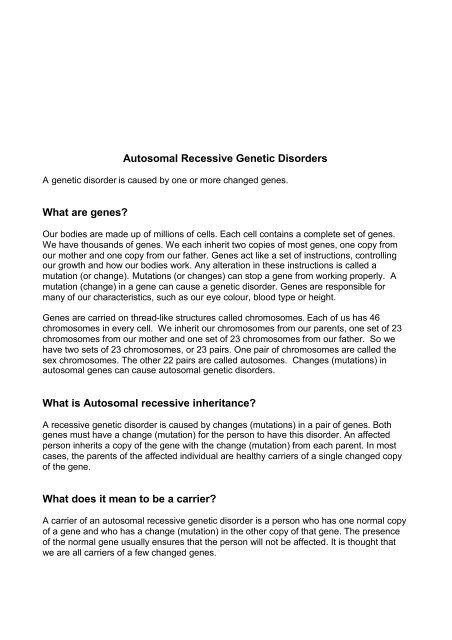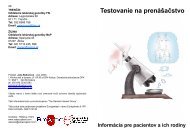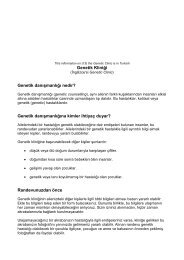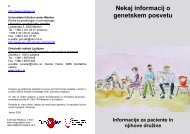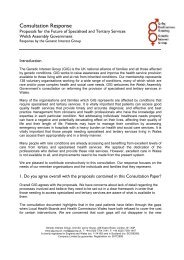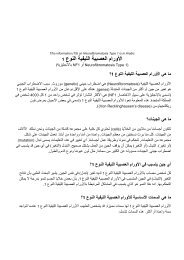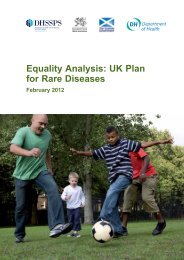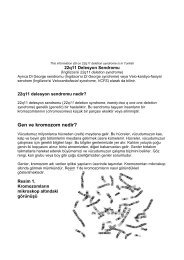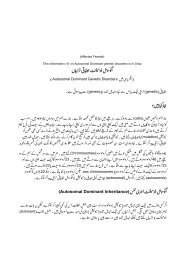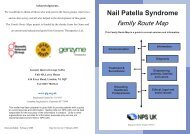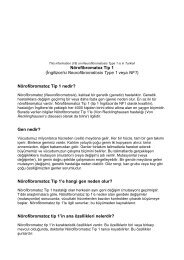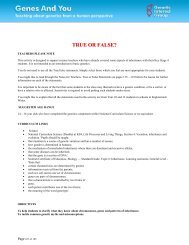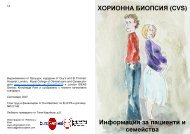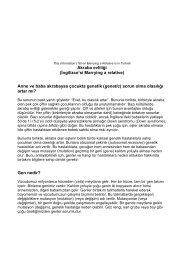Autosomal Recessive Genetic Disorders - Genetic Alliance UK
Autosomal Recessive Genetic Disorders - Genetic Alliance UK
Autosomal Recessive Genetic Disorders - Genetic Alliance UK
Create successful ePaper yourself
Turn your PDF publications into a flip-book with our unique Google optimized e-Paper software.
<strong>Autosomal</strong> <strong>Recessive</strong> <strong>Genetic</strong> <strong>Disorders</strong><br />
A genetic disorder is caused by one or more changed genes.<br />
What are genes?<br />
Our bodies are made up of millions of cells. Each cell contains a complete set of genes.<br />
We have thousands of genes. We each inherit two copies of most genes, one copy from<br />
our mother and one copy from our father. Genes act like a set of instructions, controlling<br />
our growth and how our bodies work. Any alteration in these instructions is called a<br />
mutation (or change). Mutations (or changes) can stop a gene from working properly. A<br />
mutation (change) in a gene can cause a genetic disorder. Genes are responsible for<br />
many of our characteristics, such as our eye colour, blood type or height.<br />
Genes are carried on thread-like structures called chromosomes. Each of us has 46<br />
chromosomes in every cell. We inherit our chromosomes from our parents, one set of 23<br />
chromosomes from our mother and one set of 23 chromosomes from our father. So we<br />
have two sets of 23 chromosomes, or 23 pairs. One pair of chromosomes are called the<br />
sex chromosomes. The other 22 pairs are called autosomes. Changes (mutations) in<br />
autosomal genes can cause autosomal genetic disorders.<br />
What is <strong>Autosomal</strong> recessive inheritance?<br />
A recessive genetic disorder is caused by changes (mutations) in a pair of genes. Both<br />
genes must have a change (mutation) for the person to have this disorder. An affected<br />
person inherits a copy of the gene with the change (mutation) from each parent. In most<br />
cases, the parents of the affected individual are healthy carriers of a single changed copy<br />
of the gene.<br />
What does it mean to be a carrier?<br />
A carrier of an autosomal recessive genetic disorder is a person who has one normal copy<br />
of a gene and who has a change (mutation) in the other copy of that gene. The presence<br />
of the normal gene usually ensures that the person will not be affected. It is thought that<br />
we are all carriers of a few changed genes.
2<br />
Generally, the chance that someone who carries a gene with a change (mutation) will<br />
choose a partner who happens to carry the same changed (mutated) gene is small (if the<br />
partner is not a close relative and does not have a family history of the same genetic<br />
problem). If both partners in a couple are carriers of the same changed gene, they are at<br />
risk of having a child with a genetic disorder. The chance that such a couple will have an<br />
affected child is one in four (1 in 4, or 25%) for each pregnancy.<br />
Parents can sometimes misunderstand the 1 in 4 risk. Parents who have one child<br />
affected by a recessive disorder may think that a 1 in 4 risk means that the next 3 children<br />
cannot be affected. This is not true. The risk (25% or 1 in 4) is the same for every<br />
pregnancy.<br />
There is also a 2 in 4 chance that a child will inherit a single copy of the gene with the<br />
change (mutation). Children who inherit just one copy of the gene with the change<br />
(mutation) will be healthy carriers like their parents.<br />
This information is summarised in Picture 1.
3<br />
Picture 1. How recessive genes are passed on by carriers<br />
These shapes represent a pair of genes<br />
This shape represents a normal copy of the gene<br />
This shape represents a copy of the gene with a mutation (change)<br />
Both parents are carriers; they both have a change (mutation) in one copy of the gene.<br />
They both have one normal copy of the gene. There are four possible ways for the parents<br />
to pass on their genes<br />
Father<br />
Mother<br />
unaffected child unaffected child unaffected child affected child<br />
neither gene has the<br />
both genes<br />
change (mutation)<br />
have the change<br />
(mutation)<br />
These children are carriers, like their parents
4<br />
Carrier Testing and Prenatal Diagnosis<br />
Carrier testing is available for some recessive conditions. This test can establish whether a<br />
person carries a change (mutation) in a particular gene. If both partners are found to carry<br />
a change (mutation) in a gene for the same condition, then it may be possible to offer<br />
prenatal diagnosis. Prenatal diagnosis involves testing a baby for a genetic disorder during<br />
the mother’s pregnancy. It is currently possible for only a limited number of recessive<br />
disorders.<br />
Where can I find out more?<br />
More information can be obtained from your local regional genetics centre or from these<br />
addresses:<br />
The <strong>Genetic</strong> Interest Group<br />
Unit 4D, Leroy House,<br />
436 Essex Rd.,<br />
London, N1 3QP<br />
Telephone: 020 7704 3141<br />
Email: mail@gig.org.uk<br />
Web: www.gig.org.uk<br />
Contact a Family<br />
209-211 City Rd.,<br />
London, EC1V 1JN<br />
Telephone: 020 7608 8700 FAX: 020 7608 8701 Helpline 0808 808 3555 or Textphone<br />
0808 808 3556 (Freephone for parents and families, 10am-4pm, Mon-Fri)<br />
e-mail: info@cafamily.org.uk<br />
Web: www.cafamily.org.uk<br />
This edition prepared in July 2005 Ref 2
5<br />
Glossary (difficult words and their meanings): <strong>Autosomal</strong> <strong>Recessive</strong><br />
<strong>Genetic</strong> <strong>Disorders</strong><br />
This glossary is intended only to explain terms used in the information: <strong>Autosomal</strong><br />
<strong>Recessive</strong> <strong>Genetic</strong> <strong>Disorders</strong>. Words shown in bold are defined elsewhere in the<br />
glossary.<br />
autosomal. Involving the autosomes.<br />
autosomal recessive (genetic disorders. <strong>Disorders</strong> caused when a person inherits<br />
two copies of an autosomal gene with a change (mutation) in both copies. A person who<br />
has only one copy of that autosomal recessive gene with the change (mutation) will be an<br />
unaffected carrier. A person who is affected with an autosomal recessive disorder inherits<br />
one copy of the disease gene with the change (mutation) from each parent.<br />
26/ autosomes (autosomes, autosomes). The 44 chromosomes (22 pairs)<br />
which are not sex chromosomes.<br />
38/ carrier (carrier, carrier). Someone who has one normal copy of an autosomal<br />
recessive gene and who has a change (mutation) in the other copy of that gene. The<br />
presence of the normal gene usually ensures that a carrier is not affected by the<br />
corresponding autosomal recessive genetic disorder.<br />
cell. The human body is made up of millions of cells, which are like building blocks. There<br />
are many specialised types of cells. These include skin cells, brain cells, and blood cells.<br />
Cells in different parts of the body look different and do different things. Every cell (except<br />
for eggs in women and sperm in men) contains all the body’s genes.<br />
chromosomes. Thread-like structures which can be seen under the microscope and<br />
contain the genes. Usually people have 46 chromosomes in every cell. There are two sex<br />
chromosomes. The other 22 pairs of chromosomes (numbered 1 to 22) are called<br />
autosomes. Twenty-three chromosomes come from the mother, and twenty-three come<br />
from the father. One chromosome of each pair comes from each parent. (As an analogy: a<br />
chromosome is like a book; a gene is like a story in the book).<br />
gene. Information needed for the body to work, stored in a chemical form on<br />
chromosomes. Changes or mutations in genes alter the information and this can<br />
change how the body works. <strong>Autosomal</strong> genes are in pairs: one from the mother, one<br />
from the father. The two genes of a pair are at matching places on a pair of<br />
chromosomes. (As an analogy: a chromosome is like a book, a gene is like a story in<br />
the book, a change or mutation in a gene is like a missing or extra letter in a word in the<br />
story).<br />
genetic. Caused by genes, concerning genes.
6<br />
mutation. A change in a gene. Some mutations are not harmful. Sometimes when a<br />
gene is changed, its information is altered so it does not work properly. (As an analogy: a<br />
change or mutation in a gene is like a missing or extra letter in a word in a story).<br />
prenatal diagnosis. Test during a pregnancy for the presence or absence of a genetic<br />
disorder in the baby.<br />
sex chromosomes. The X chromosome and the Y chromosome. The sex<br />
chromosomes control whether a person is male or female. Females have two X<br />
chromosomes. Males have one X and one Y chromosome.<br />
This glossary is intended only for use by patients and families, with the genetic information<br />
to which it refers.<br />
This edition prepared in July 2005 Ref Glossary 2


